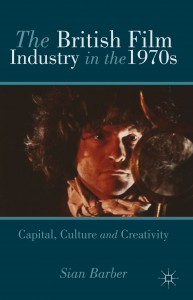The British Film Industry in the 1970s: Capital Culture and Creativity by Sian Barber. Palgrave Macmillan, 2013.. 221 pages. ISBN 978-0230360852 (hardback), £50
 About the reviewer: Dr E. Anna Claydon, Lecturer in Media and Communication at the University of Leicester, is author of The Representation of Masculinity in British Cinema of the 1960s (2005). Her other publications include: 'National Identity, the GPO Film Unit and Their Music', in The GPO Film Reader (BFI/Palgrave, 2011); 'Masculinity and Deviance in British Cinema of the 1970s: Sex, Drugs and Rock and Roll’ in Don’t Look Now? British Cinema in the 1970s (Intellect, 2010).
E-mail: eac14@le.ac.uk
About the reviewer: Dr E. Anna Claydon, Lecturer in Media and Communication at the University of Leicester, is author of The Representation of Masculinity in British Cinema of the 1960s (2005). Her other publications include: 'National Identity, the GPO Film Unit and Their Music', in The GPO Film Reader (BFI/Palgrave, 2011); 'Masculinity and Deviance in British Cinema of the 1970s: Sex, Drugs and Rock and Roll’ in Don’t Look Now? British Cinema in the 1970s (Intellect, 2010).
E-mail: eac14@le.ac.uk
Sian Barber’s entertaining new book aims to perform a substantial task, to 'definitively map the legislative and economic constraints on the British film industry in the 1970s' (Barber, 2013: 1), but what she actually gives the reader is something more complex, a study which does not just map the socio-economic and historical issues but also begins to present a series of textual analyses which build upon what has been demonstrated contextually. A core argument in Barber’s analysis is that, in the 1970s, Durgnat’s (1970) cinema as 'a mirror of society' thesis collapses because the relationship of art to society and history becomes more malleable: 'the meanings of the past', she writes, 'are shown to be no longer fixed and settled [thus the] films allow the past to be plundered for a variety of purposes' (Barber, p3). Consequently in mapping the industry through its archival evidence for the period, what Barber begins to elucidate is a cinema aware of its place in history but sometimes specifically and creatively inverting the concerns of the contemporary into a reframing of the past, present and future through a process of destabilisation.
 As such, in her six case studies, of films which span the different types of production (Sunday Bloody Sunday, The Go Between, Confessions of a Window Cleaner, Stardust, Scum and The Tempest), what is seen is how British cinema of the period defies definition and is caught between the cultural revolution of the sixties and the coming tensions of the eighties - from, on the one hand, a use of improvisation to free performance from the script to, on the other, the use of order to question disorder. As she notes herself early in the book, rather than thinking of the films through the reflection metaphor, '[a] more useful model for understanding the 1970s is perhaps the base/superstructure proposed by Raymond Williams [whereby] the economic base creates the cultural produces which form the superstructure of any given society' (ibid, 5). There is a great deal of saliency in this argument because whilst we have to see films as a result of their circumstances, it is not always useful to see the content of those films as reflecting the moment but rather as commenting upon them (as in the case of Jubilee or Tommy).
As such, in her six case studies, of films which span the different types of production (Sunday Bloody Sunday, The Go Between, Confessions of a Window Cleaner, Stardust, Scum and The Tempest), what is seen is how British cinema of the period defies definition and is caught between the cultural revolution of the sixties and the coming tensions of the eighties - from, on the one hand, a use of improvisation to free performance from the script to, on the other, the use of order to question disorder. As she notes herself early in the book, rather than thinking of the films through the reflection metaphor, '[a] more useful model for understanding the 1970s is perhaps the base/superstructure proposed by Raymond Williams [whereby] the economic base creates the cultural produces which form the superstructure of any given society' (ibid, 5). There is a great deal of saliency in this argument because whilst we have to see films as a result of their circumstances, it is not always useful to see the content of those films as reflecting the moment but rather as commenting upon them (as in the case of Jubilee or Tommy).
One of the things Barber writes most passionately about is the necessity to combine historical enquiry with textual analysis and to see one as part of a process that leads to the other. Her discussion of this is a useful summary of why and how so many of us who write about British cinema for the last twenty years have been persistently trying to ensure a pluralistic approach to film study. The archives, the hard data and the society in which a film has been produced are essential foundation stones upon which any textual analysis must be built. However, there is a quality to Barber’s appraisal of the relationship of text and context in film studies which makes the reader concerned she is a little defensive of her position. No defence is necessary: Barber is preaching to the choir given the readership this book will invite. We do not need convincing.
... a great companion text to any module teaching British cinema of the period
So, in summary, is Barber’s book a worthwhile read and how might you use it? Yes, British Film in the 1970s is a great companion text to any module teaching British cinema of the period but it also is a useful text to encourage those working on other times and places to ask questions about the framing of other periods and national cinemas. Researchers will also find the book useful for similar reasons but principally because of its account of specific archives and in raising new questions about the connectivity between art(s) and society(ies) which encourages a cognitive disconnect between what we are told we should see and what we actually, often, find.
Dr E. Anna Claydon